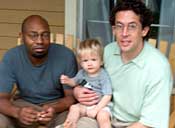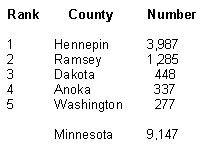Census shows more same-sex couples in Minnesota
By Art Hughes
Minnesota Public Radio
August 1, 2001
Part of MPR's online coverage of The Faces of Minnesota
New numbers from the U.S. Census Bureau show same-sex households account for nearly one percent of all Minnesota couples. The 2000 Census figures provide the agency's most accurate count yet of same-sex couples. Advocates and officials alike say the numbers still don't accurately track the true number of gays and lesbians, but are an important marker nonetheless.
WHEN SEAN KERSHAW and Tim Hawkins adopted their son, Aidan, Kershaw says neighbors brought the usual baby gifts and clothes and no one seemed at all concerned that Aidan has two fathers. Kershaw, a planner with the city of St. Paul, says that kind of basic support makes Minnesota a welcome place for gay relationships.
"It's a safe state. There are laws that protect you from discrimination. There are similar protections in other states, but this is an easier state to be gay in, quite frankly. I wouldn't be surprised more than in others," Kershaw says.
The 2000 Census reports more than 18,000 Minnesotans living together in a gay or lesbian relationship - nearly one percent of all couples in the state, married or otherwise.
Last year was the first time the Census Bureau counted same-sex couples. In 1990, gay and lesbian couples listed their relationship status on the census form in a variety of ways including "married." Since same-sex marriages aren't recognized legally, the Census Bureau ended up reclassifying those in several categories, such as "room mates" or even "relatives," none of which accurately reflects reality.
Kershaw believes - and census officials generally agree - that the latest numbers are probably low because some gay couples still fear a backlash.
"'We're here, we're queer, we're enumerated' is not sexy or exciting," he says. "I think there's some hesitancy to see those numbers. On the other hand I think people are excited to see reality validated. You know we're a presence, we've been here all along and we're growing perhaps. I think there's some hesitancy to turn over these numbers because so many people are unfriendly to gays."
Deborah Talen, the director of Rainbow Families, a non-profit that facilitates adoptions and provides support for same-sex parents, says Minnesota is supportive of gay and lesbians, but barriers remain both legally and perceptually.
"The fact that we can't get legally married means we have to adopt as a single person. Even if you go to the adoption agency and say we're a couple we went through a ceremony, been together 10 years. Still, in the law you have to adopt as a single person. Singles are limited in the kind of adoptions they can have," Talen says.
Talen says her organization's first conference six years ago had an attendance of 100 parents and 50 kids. More than 1,000 people attended that same conference this year.
Talen says the fact that the census now counts same-sex partners reflects an attitude that gays and lesbians are considered more mainstream than in the past.
More than half of the state's gay couples live in the Twin Cities, with the largest number - almost 4,000 - living in Hennepin County. Still, gay households make up less than one percent of all households in the county. Slightly more females than males reported having same-sex partners.
The number of both same-sex and opposite-sex unmarried partners took a large leap from 10 years ago. In 1990, the census measured 60,000 unmarried couples. Last year the agency counted 100,000 - a 67 percent increase.
Minnesota state demographer Tom Gillaspy says the numbers are an important measurement of who we are and can help shape vital public policy issues. "One of the big policy questions of this past decade has to do with things like insurance - health insurance in unmarried partner households, visitation rights in hospitals - if one of the partners became seriously ill. And a variety of similar kinds of issues that we didn't really have very good data on," according to Gillaspy.
The lowest number of same-sex partners in Minnesota is in Kittson County, which has a single couple. Lincoln has two same-sex households. Traverse and Red Lake Counties each have three.
By Art Hughes
Minnesota Public Radio
August 1, 2001
Part of MPR's online coverage of The Faces of Minnesota
|
|
RealAudio |
| |
|
|
|
||
WHEN SEAN KERSHAW and Tim Hawkins adopted their son, Aidan, Kershaw says neighbors brought the usual baby gifts and clothes and no one seemed at all concerned that Aidan has two fathers. Kershaw, a planner with the city of St. Paul, says that kind of basic support makes Minnesota a welcome place for gay relationships.
"It's a safe state. There are laws that protect you from discrimination. There are similar protections in other states, but this is an easier state to be gay in, quite frankly. I wouldn't be surprised more than in others," Kershaw says.
The 2000 Census reports more than 18,000 Minnesotans living together in a gay or lesbian relationship - nearly one percent of all couples in the state, married or otherwise.
Last year was the first time the Census Bureau counted same-sex couples. In 1990, gay and lesbian couples listed their relationship status on the census form in a variety of ways including "married." Since same-sex marriages aren't recognized legally, the Census Bureau ended up reclassifying those in several categories, such as "room mates" or even "relatives," none of which accurately reflects reality.
| |
|
|
|
||
Deborah Talen, the director of Rainbow Families, a non-profit that facilitates adoptions and provides support for same-sex parents, says Minnesota is supportive of gay and lesbians, but barriers remain both legally and perceptually.
"The fact that we can't get legally married means we have to adopt as a single person. Even if you go to the adoption agency and say we're a couple we went through a ceremony, been together 10 years. Still, in the law you have to adopt as a single person. Singles are limited in the kind of adoptions they can have," Talen says.
Talen says her organization's first conference six years ago had an attendance of 100 parents and 50 kids. More than 1,000 people attended that same conference this year.
| |
|
|
|
||
The number of both same-sex and opposite-sex unmarried partners took a large leap from 10 years ago. In 1990, the census measured 60,000 unmarried couples. Last year the agency counted 100,000 - a 67 percent increase.
Minnesota state demographer Tom Gillaspy says the numbers are an important measurement of who we are and can help shape vital public policy issues. "One of the big policy questions of this past decade has to do with things like insurance - health insurance in unmarried partner households, visitation rights in hospitals - if one of the partners became seriously ill. And a variety of similar kinds of issues that we didn't really have very good data on," according to Gillaspy.
The lowest number of same-sex partners in Minnesota is in Kittson County, which has a single couple. Lincoln has two same-sex households. Traverse and Red Lake Counties each have three.



